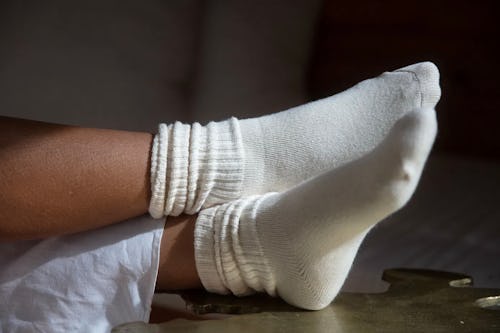
Stuck on what to give? Don’t stress — we’ve got you covered. From clever gadgets to stylish finds, these gifts start at just $5 and are anything but boring. Whether you’re shopping for a coworker, a friend, or that one person who’s impossible to shop for, these budget-friendly picks are thoughtful, fun, and guaranteed to impress.
This humidifier diffuser lamp that brings the cozy vibes
For all the cozy vibes, this compact humidifier lamp will help keep the air comfortable while also creating a soothing flame-like effect. You can even add essential oils and use it to diffuse your favorite scents.
This Genius Underwear With A Zero-G Pouch & Horizontal Fly
Finally, underwear that understands the assignment. Made with smooth, breathable MicroModal® fabric, these boxer briefs offer next-level comfort. The Zero-G pouch keeps everything supported (no more awkward adjustments), and the horizontal fly makes quick access a breeze. No chafing, no sagging, no bacteria build-up—just lightweight, anti-odor greatness. On sale now for a serious upgrade to your basics drawer.
This easy-to-use device that promises to remove unwanted hair for good
Anyone who’s explored permanent hair removal knows it can require a hefty investment — not to mention a lot of salon visits. That’s why the LUMI has already created such a buzz since its launch in 2022. The handheld device uses intense pulsed light to target unwanted hair at the roots — and it’s designed to be safe and gentle enough for at-home use. According to the brand, many users start seeing results in just three weeks, with full results after six to 12 weeks of regular use. It’s an especially great option if you’re prone to painful ingrown hairs from shaving or waxing.
This Stylish Jigsaw That’s Great For Puzzle Lovers
This 500-piece puzzle from Parks Project x Dr. Seuss is a great gift for puzzle lovers and Dr. Seuss fans alike. With just the right level of challenge, it’s ideal for a relaxing evening or a group activity. A thoughtful gift that brings fun, nostalgia, and a touch of whimsy to any occasion.
This Steak Subscription That Will Impress The Hell Out Of Meat-Lovers
Treat your favorite foodie (or yourself!) to the gift of gourmet with Omaha Steaks. Its subscription program hooks you up with 12 free burgers in every shipment—for life—plus 10% off and locked-in prices, no matter how much grocery costs climb. With top-notch quality, bonus perks, and plenty of flexibility, it’s an indulgent but budget-friendly way to make mealtime feel extra special. Perfect for meat-lovers on your list.
A Jewelry Bundle That’s A Surprise To Give & Receive
Stuck in a gifting rut? This jewelry surprise bag is here to save the day. For $60, you’ll snag four pieces—rings, necklaces, bracelets, earrings, or hair accessories—worth up to $200. Bonus: free shipping and an option to get it gift-wrapped for $5. It’s like the thrill of a mystery box, but make it sparkly.
Super Comfy Sneakers That Are Shockingly Cheap
This 4D shaver for a smoother shave
This rechargeable electric shaver has an ergonomic handle for comfortable use. It incorporates five rotating shaving heads that glide smoothly over your skin, minimizing the risk of nicks or razor burn. Additionally, it is waterproof, making it suitable for use in the shower and effective on dry skin.
A Baby Tee That Contributes To Park Conservation
This fitted baby tee isn’t just a wardrobe MVP that can take you from gym runs to Target hauls—it’s also doing some serious good. Made from recycled polyester and cotton, it’s printed with Parks Project’s mantra: “Leave it better than you found it.” And they walk the walk, too: As a B Corp certified company, they’ve donated over $2 million to national parks across the U.S. So, you’re not just wearing a cute tee; you’re supporting a greener future.
This luxurious bamboo sheet set that’s 50% Off
Sales days are the perfect time to upgrade your bedding for less, and with these cozy bamboo sheets you will feel like royalty. Made of 100% bamboo viscose, the temperature-regulating sheets will help keep you comfortable all year round. They boast an OEKO-TEX certification, which means they’ve been tested to ensure they’re free of certain harmful chemicals. And they come in a nice range of colors and sizes so you can find just the right fit for your bedroom.
- Available sizes: Twin — California King
- Available colors: 7
These Cult-Favorite Socks From Maggie’s Organics
Made for everyone and every occasion, these socks work just as well with dress shoes as they do with sneakers. Soft, durable, and designed for year-round wear, they're the reliable staple you'll reach for every day. Plus, they're Fair Trade certified, knit and dyed in the USA since 1992. Crafted with 98% organic cotton and just the right amount of stretch, they stay snug without feeling tight. Easy care, easy wear — because comfort shouldn't be complicated.
A cozy hoodie that has the perfect oversized fit
Brown is trending right now, and this garment-washed hoodie comes in a versatile, slightly faded chocolate shade that goes with gray, cream, and black — in short, with everything. Designed with a kanga pocket and ribbed trim, the slightly cropped length allows you to enjoy the oversized fit without being overwhelmed by fabric.
This Smudge Kit That Comes With Everything Needed To Banish Bad Energy
Cleanse your space and elevate your vibe with this Smudge Kit, beautifully housed in a chic midi vase. Featuring palo santo, sage, lavender, selenite, and agate, it’s everything you need to banish bad energy, boost creativity, and invite calm. Perfect for gifting or self-care rituals.
A 3-Pack Of Effortlessly Cool T-Shirts
Giving someone a pack of quality tees ensures that they’ll always have a cozy shirt to lounge in or layer. The oversize silhouette on the Elwood Core Tee features a drop shoulder in garment-washed organic cotton that will look like they’ve had these tees forever, and only increase in softness over time.
These stretchy, stain-resistant pants that feel as good as they look
Jack Archer is a brand that believes clothes should feel as good as they look, and its Jetsetter Tech Pant is no exception. With a tailor-made feel, the versatile pants are available in a range of inseam lengths, as well as in a slim and straight cut. They're made with the brand's superior Rebound fabric, which offers just the right balance of softness and stretch while also resisting water and stains — so they'll look just as good at the end of the day as they did when you first slipped them on.
These fan-favorite Skechers that are podiatrist approved
With these podiatrist-backed Skechers sneakers, you can walk in comfort and in style. The bestselling slip-ons feature a podiatrist-designed shape paired with superior arch support, and they come in your choice of seven colors. On top of that, they're machine washable for easy care. Get 30% off as a Skechers Plus member when you use code EARLY.
This Tiny, Adorable Retro Karaoke Machine
Karaoke on the go? Yes, please! This little machine might be mini, but it’s packed with fun. It’s got voice-changing features (like baby voice and KTV), a solid 4-hour battery life, and doubles as a speaker for your playlists. Whether it’s a spontaneous party or a solo jam session, this tiny powerhouse is ready to bring the vibes anywhere you go.
Tthese plush down feather pillows with a “3-chamber” design
Ready to up the cozy factor of your bed? Now’s your chance to snag these plush down feather pillows for a great price. Each one has a “three-chamber” construction to give you the perfect balance of softness and support. It comes in your choice of medium or firm, as well as three sizes, so you are sure to find your perfect match here.
- Available sizes: Standard, Queen, King
- Available styles: 2
This nourishing clay mask for their booty
Yes, it is exactly what it sounds like — this clay mask is formulated specifically to nourish the skin on your bum, for cheeks that feel soft and smooth. It features skin-loving ingredients like Australian white clay, artichoke extract, hyaluronic acid, and caffeine to help hydrate, enhance texture, and soothe irritation.
This reed diffuser for National Parks lovers
Channel the peaceful vibes of a cherished National Park with this reed diffuser from Parks Project. The cruelty-free fragrance channels crisp notes of pine, and it comes in a 8-ounce amber bottle with nine reeds to give you plenty of mileage.
A Heated Eye Massager That’ll Help Melt Away Stress
Long day? Too much screen time? Say no more. This heated eye massager is like having a tiny spa right in your bag. It’s perfect for melting away stress, soothing headaches, and easing tired eyes. Compact, portable, and oh-so-relaxing, it’s the ultimate self-care tool for whenever you need a little tranquility.
This Nourishing K-Beauty Moisturizer With Snail Mucin
Whether you're new to the benefits of snail mucin or always looking for fresh ways to work it into your skin care routine, now is the best time to try Zen Dew's Moon Milk moisturizer. Formulated with 91% snail mucin, this K-beauty cream is new to Amazon but already winning over reviewers, with many gushing over how it leaves their skin feeling hydrated and soothed.
This Genius Little Nano Face Mister & Mirror
Need a quick refresh? This pocket-sized face mister has your back. A spritz of hydration keeps your skin dewy and glowing, whether you’re heading to a meeting, leaving the gym, or just powering through your day. Bonus: it’s got a built-in mirror for touch-ups on the fly. Your skin—and your selfies—will thank you.
This customizable candle that’s perfect for pet lovers or parents
When it comes to clever gifts for pet owners (or yourself), few can hold a candle to this customizable creation from TAJA Collection. Just upload a photo of a favorite furry friend for a unique and functional keepsake. You can even choose the size, votive color, and fragrance (with delightful scent options like vanilla bourbon, mistletoe, and gilded champagne).
This Binder-Style Organizer That Lets You Customize Your Journal/Planner
Who says staying organized can’t be cute? This vegan leather notebook has everything: a zipper pouch, card slots, sticky notes, and even a pen holder. It’s perfect for planning, journaling, or sketching, with a design that’s as functional as it is stylish. Keep all your essentials in one place and look good doing it.
































